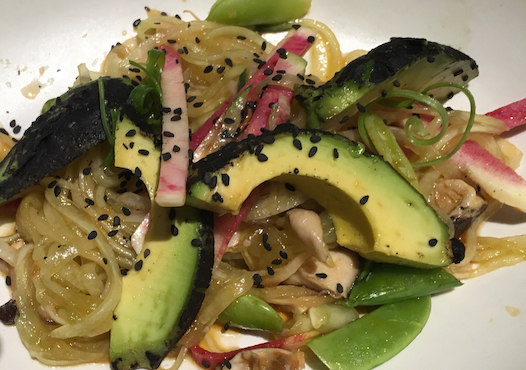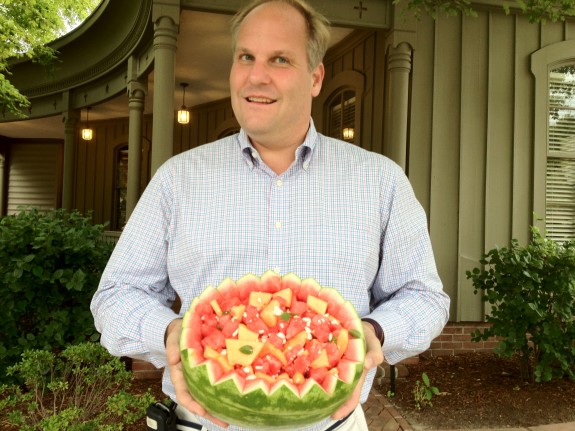10 Tips for Enjoying Halloween Candy Without Guilt or Consequences
- At November 01, 2017
- By Katherine
- In News, Recipes
 0
0
Now that you have all that Halloween candy, what is a healthy way to handle it, especially for your children? You don’t need to think of candy as “bad.” Studies over the years have found there is no association between candy eating and poor health or weight gain. But eating candy in moderation helps.
There are a few simple strategies designed by behavioral scientists and nutritionists to help your children (or you) enjoy candy without guilt or even weight gain. Remember:
1. Moderation is more realistic than complete elimination,
2. Eat about 10% of your daily calorie needs as candy and you can still maintain a healthy body and weight (most women consume about 1800 calories/day, so their candy allottment might be 180 calories daily. For men, perhaps about 220 calories),
3. When candy is in the house, it’s fair game for everyone. Denying access to candy your child knows is in the house (and they always know!) is counterproductive and can eventually lead to bingeing when it becomes available,
4. Remove the emphasis on restriction. If you don’t want someone in your house eating candy, don’t have it in the house. This changes the emphasis from what you “can’t” have, to what you “can” have,
5. Structure your family’s eating. Eat regularly scheduled meals at predictable times through the day,
6. Provide reasonable guildelines for eating the candy that is in the house, and practice what you preach,
7. If you’d like your child to eat candy moderately, limit how often it is brought into the home and serve small portions, or use pre-packaged candy in small amounts,
8. Serve all food positively. Fruits, vegetables and other wholesome foods should be presented just as positively as candy,
9. Don’t use candy as a reward of any kind,
10. Above all else, provide a consistently positive atmosphere in which all food is eaten. There is no “good” or “bad” food. All food fits, but you may need to define the balance, amounts, and timing that candy or any food is eaten in the household.
Nora Pouillon’s Classic Ratatouille
- At October 22, 2017
- By Katherine
- In News, Recipes
 0
0
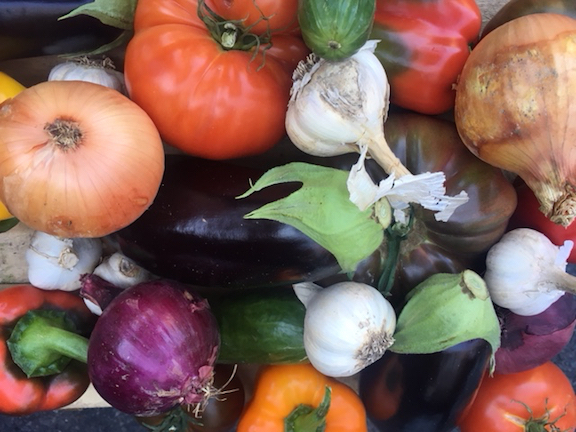
Vegetables for Nora’s Ratatouille were all Found at Twin Springs Fruit Farm Stand from Ortanna, PA (90 Miles from DC)
Nora Pouillon’s Ratatouille
Adapted from
“Cooking with Nora”
And Excerpted from “Diet Simple”
Ratatouille is an authentic aromatic Provençal ragout of onions, eggplants, peppers, zucchini, and tomatoes, stewed slowly in olive oil and flavored with garlic and fresh herbs. At the Dupont Circle Fresh Farm Market, I recently found every vegetable and herb needed for this amazingly tasty and versatile dish – all from Twin Springs Fruit Farm in Ortanna, Pennsylvania. The farmers travel 90 miles to provide us city folks with the freshest, juiciest, most delicate fruits and vegetables to be had – not to mention the extraordinary nutrition they provide!
Cutting up the vegetables is time consuming and that is why I like to make double or more than the amount I need and use the leftovers …
• at room temperature the next day with grilled chicken or fish.
• mixed with eggs and cheese for a Quiche Provencal.
• heated up and stirred with beaten eggs, spiced with chilis and served with sliced ham, Prosciutto, or cooked lean sausage as Piperade or Basque dish.
• reheated and used as sauce for freshly cooked pasta, garnished with feta or goat cheese, with the addition of pitted black olives if desired.
• As Minestrone, heated with vegetable or chicken stock, adding a can of drained cannellini beans and maybe a spoon of pesto on top.
The trick of a good ratatouille is not to overcook the vegetables. They have to be added one after the other, depending on the amount of time they need to cook to be just tender. Of course, Nora recommends all the vegetables be organic.
6 – 8 servings
1/2 cup olive oil
1 large onion, chopped
1 Tablespoons garlic, minced
1-2 eggplants (2 lbs) cut into 1-inch cubes
2 peppers, red, green or yellow, cut into 1-inch squares
2 zucchini (1.5 lbs) cut into 1-inch cubes
1.5 lbs tomatoes, peeled and cut into 1-inch cubes
salt and freshly ground black pepper
1 Tablespoon thyme, minced
1/2 Tablespoon rosemary, minced
2 Tablespoon parsley or basil, minced
Heat the olive oil in a large skillet until hot.
Add the onions and stew for 10 minutes until soft. Add the garlic, then the eggplants and peppers, cover and cook slowly for 20 minutes.
Add the zucchini, cook for 5 minutes, then lastly add the tomatoes and cook for an additional 5 minutes or less.
Season with salt and pepper and the minced herbs.
Calories 220 Percent of Daily Value
Calories from Fat 150
Total Fat 16g 25%
Saturated Fat 2g 11%
Cholesterol 0mg 0%
Sodium 15mg 1%
Total Carbohydrate 18g 6%
Dietary Fiber 6g 22%
Soluble Fiber 1.13 g
Omega 3 Fatty Acids 0.14 g
Sugars 10g
Protein 3g
Vitamin A 60%
Vitamin C 160%
Calcium 4%
Iron 8%
A Natural Remedy for Coughing
- At September 26, 2017
- By Katherine
- In News, Recipes
 0
0
I don’t know about you, but I’ve noticed a lot of sniffles and coughing going on this season (and unfortunately, that includes me!). Whether it’s from an allergy, a cold, an upper respiratory tract infection, post nasal drip, or gastroesophageal reflux disease (GERD), there’s an age-old remedy for coughing that has been recently proven by science to be effective. The ingredient is easily available, and is often a staple in your own kitchen.
What is it? Honey. “An 8,000 year old cave painting in Spain depicts honey harvesting, and we know it’s been used for food, medicine, and more by cultures all over the world since,” according to Ullman’s Encyclopedia of Industrial Chemistry.
“Coughing is a protective reflex action triggered by irritation or obstruction of the airwaves,” according to this study in Pediatric Reports. “There is a high prevalance in children and it impacts a child’s ability to sleep, play and eat. It is the largest single cause of primary care doctor visits.”
Honey was found to be more effective than dextromethorphan, found in common over-the-counter cough medicines, according to this study reported in Archives of Pediatric Adolescent Medicine. In fact, these results found the medicine was no better than the placebo.
In another study, coughing was reduced and sleep was improved in 2-year-olds with upper respiratory tract infections when they were given 2 teaspoons of honey before bedtime. In the study, honey was as effective as dextromethorphan, according to the Mayo Clinic.
A similar conclusion was found in a review of studies published in Cochrane Database Systematic Reviews, when children aged 1 to 18 were tested.
The World Health Organization identifies honey as a potential treatment for cough.
Honey is an especially good potential remedy for children, as it could be a natural way to avoid overuse of drugs like antibiotics (but check with your doctor first!).
Honey Cough Syrup
1-1/2 Tablespoons Zest of 2 Lemons
1/4 Cup Peeled, Sliced Ginger or 1/2 teaspoon of Ground Ginger
1 Cup Water
1 Cup Honey
1/2 Cup Lemon Juice
In a small saucepan combine lemon zest, sliced ginger ad 1 cup of water. Bring mixture to a boil and simmer for 5 minutes. Then strain into a heat-proof measuring cup. Rinse the saucep and and pour in 1 cup of honey. On low heat, warm the honey but don’t allow it to boil. Add the strained lemon ginger water and the lemon juice. Stir the mixture until it combines to form a thick syrup. Pour into a clean jar with a lid. This can be refrigerated for up to 2 months.
* Recipe by the National Honey Board
The Perfect Labor Day Recipe: Katherine’s Salsa Fresca with Watermelon
- At September 01, 2017
- By Katherine
- In News, Recipes
 0
0
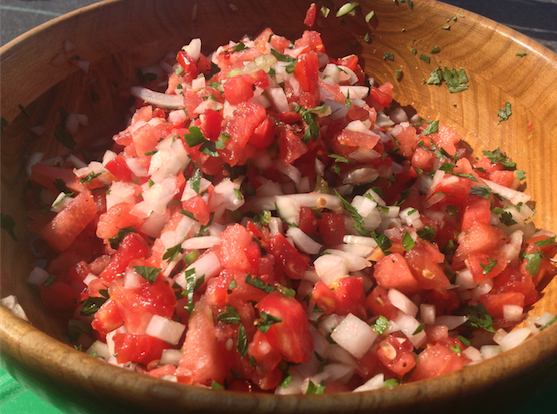
Katherine’s Spicy Salsa Fresca with Watermelon from “Diet Simple Farm to Table Recipes: 50 New Reasons to Cook in Seasons!”
Katherine’s Spicy Fresh Salsa with Watermelon
www.KatherineTallmadge.com
excerpted from “Diet Simple Farm to Table Recipes: 50 New Reasons to Cook in Season!” ($4.95)
Nothing could be a more perfect Labor Day recipe. Featuring the best fruit of the season! It contains all the flavors: sweet, savory, spicy, and salty. I usually use vine-ripe tomatoes for my fresh salsa, excerpted from my book, Diet Simple. But watermelon is a surprising and exotically delicious substitute for all the tomatoes, or just half of them – as in this version. Serve this salsa with grilled salmon, chicken or beef… even tortilla chips… whatever you may traditionally use salsa with.
22 servings
Ingredients:
1 lb vine-ripe, fresh tomatoes, coarsely chopped (start with about 1-1/2 lbs)
1 lb chopped watermelon, seeds removed
1 large candy onion, peeled and chopped (about ½ pound)
3 – 4 jalapeno peppers (1 – 2 ounces), to taste
¼ cup chopped fresh cilantro
½ tsp salt, or to taste
freshly ground pepper, to taste
3 – 4 Tbsp fresh lime juice (1 – 2 limes), optional, or vinegar if you wish for the salsa to last longer in your refrigerator
Add the onion to the tomatoes and watermelon. Finely chop 2 of the jalapeno peppers to start with. Taste. If you desire more heat, add 1 – 2 more jalapenos. Mix in the cilantro. Add the salt and pepper, depending on your taste. Mix in the lime juice, if you wish.
True Food: A Truly Delicious Experience for Healthy Foodies
- At August 22, 2017
- By Katherine
- In Articles, News
 0
0
I encourage my clients to explore new and delicous ways of enjoying food. In fact, in my weight loss or lifestyle transformation programs, all favorite food is included. Why? Because “taste” will always be the primary reason we humans are willing to eat something. Good tasting food kept us alive during evolution. Anything that tasted bad might have killed us! We still have that instinct today.
So, if a “diet” or “healthy” dish you’re eating isn’t delicious, or it’s something with which you’re getting bored, you won’t stick with your healthy lifestyle. Eating food that you love is the only sustainable way to live.
This brings me to my client, Noah Arber’s, story, as she told it to me …
“Katherine! I had an incredible dining experience at True Food Kitchen in downtown Bethesda, Maryland – and many other locations – that I think your other clients might want to know about. I believe this restaurant is unique, from the food they serve, to the modern and trendy decor. They not only serve delicious and appealing food, but every item on their menu is made using colorful, fresh, and healthy ingredients. It was so enjoyable, I went back the next day. Not only was there a delicious variety to choose from, but I felt good after my meal, knowing I had put fresh, non-fatty or processed ingredients into my body. Even after trying their fruity sangria and their flourless chocolate cake, I was still down half a pound the next morning!
The first time there, my friend and I started our meal with the “Torched Avocado,” with cucumber noodles, mushrooms, snap peas, radishes, sesame, and turmeric ponzu. Next was the “Shiitake Lettuce Cups,” with tofu, jicama, sambal, thai basil, and cachew. These dishes were beautifully presented and bursting with flavors I had never tasted before – not to mention I was eating fresh, healthy ingredients.
For our entrees, we enjoyed “The Ancient Grains Bowl” with miso glazed sweet potato, turmeric, charred onion, snow peas, grilled portobello, avocado and hemp seeds. The following day, we tried the “Spaghetti Squash Casserole,” with caramerlized onion and fresh mozzarella, and the “T.L.T. Sandwich,” on multigrain toast with smoked tempeh, butter lettuce, tomato, avocado, and vegan mayonnaise. Our side was “Roasted Sweet Potato and Kale Salad.”
Needless to say, I enjoyed all the foods I tried. They were some of the most delectable dishes I’ve experienced in the D.C. food scene. I ordered their True Food cookbook, so I can make the recipes at home. I would definitely recommend you tell your friends, family, and especially your clients about it. It was truly a healthy, and most importantly, a deliciously indulgent experience. Who says you can’t eat healthfully and enjoy yourself too?”
Sweet Summertime Melon Chunks with Crumbled Feta and Fresh Mint
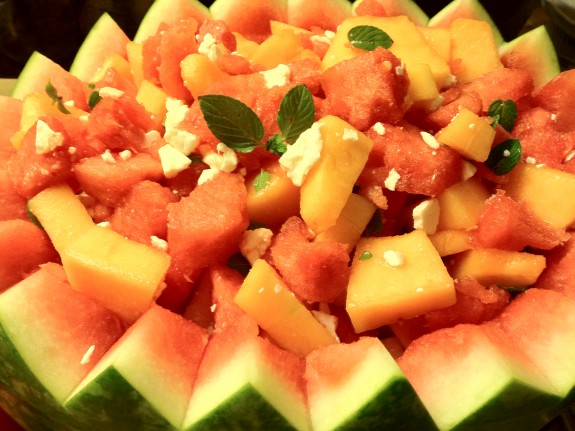
Sweet Summertime Melon Chunks with Crumbled Feta and Fresh Mint (from “Diet Simple Farm to Table Recipes”)
Excerpted from “Diet Simple Farm to Table Recipes: 50 New Reasons to Cook in Season!“
It’s melon season and a vast number of varieties are now available, and will be for quite a while. These days melons come in an amazing array of colors, shapes, textures, and flavors. Use a combination of any melons for this very simple, yet elegant recipe. This is an unusual combination of flavors and textures, and a delight on the palate. Use any kind of melon that happens to be in season.
Serves 8
2 pounds melon chunks (about 1 small cantaloupe or seedless watermelon)
½ pound Feta Cheese or other similar cheese
8 small mint leaves, Chiffonade (Basil will also work)
Combine ingredients in a large bowl and serve!
I’m In Tomato Heaven Recipe! Greek Salad with Heirloom Tomatoes
I’m in tomato heaven! Tomatoes are my favorite vegetable (maybe because they’re actually a fruit!). It all started with my Grandmother. She would plant dozens – or it seemed like dozens to a child – of tomato plants every year in her huge vegetable garden. We’d pick them ripe from the vine, and eat them while still warm from the summer sun. I’ll never forget how soft, juicy, and red throughout they were. I feel so lucky that today, we have our Farmers Markets growing these kinds of spectacular specimens… of all shapes, sizes, colors, textures, and flavors!
Heirloom tomatoes are old varieties of tomatoes which have been passed down through generations. They are tastier, but more delicate, because they’re bred to be picked and eaten right away – they’re not bred to travel (as many of the tomatoes in the grocery store may be). Heirloom varieties have natural resistance to pests, disease and are better able to tolerate local conditions without too much extra energy, pesticides or water. Locally, organically produced food saves water, energy and encourages a region’s unique varieties of fruits and vegetables.
Greek Salad with Heirloom Tomatoes
excerpted from “Diet Simple Farm to Table Recipes: 50 New Reasons to Cook in Season!” by ME (only $4.95)
Serves 8
Ingredients:
Vinaigrette:
2 Tablespoons Freshly Harvested Extra Virgin Olive Oil
2 Tablespoons Freshly Squeezed Lemon Juice (1 Lemon)
1 Tablespoon Chopped Fresh Oregano or Basil (or 1 tsp dried)
1 Clove Garlic, Minced (optional)
Salt and Pepper to Taste (Salt is not necessary with the cheese and olives)
Vegetables:
2 cucumbers, peeled, seeded and sliced into a half-moon shape
1 onion, peeled and chopped coarsely
1 medium yellow, purple or green bell pepper, cored, seeded, chopped into large bite-size pieces
1 cup pitted Kalamata or other Greek Olives
4 Heirloom Tomatoes, quartered, and cut into large, bite-size pieces (or any vine-ripe tomatoes)
4 ounces Feta or Goat Cheese, broken into small bits
Instructions:
Combine the vinaigrette ingredients in a large salad bowl and whisk until blended. Add the cucumbers, onion, pepper, and olives and toss into vinaigrette. Let sit for twenty minutes to marinate. Add the heirloom tomatoes and cheese when ready to serve.
Tomatoes are one of the “superfoods.” Men who consumed 10 or more servings of tomato products a week had a 35% decrease in risk of prostate cancer relative to those who consumed 1.5 servings or fewer per week. This is largely attributed to “lycopene” in the tomatoes, which is also in other red fruits such as watermelon, pink grapefruit and guava. Men with lycopene levels in the top 20% had a 46% decrease in risk of heart attack compared to those in the bottom 20%. Lycopene is a potent scavenger of gene-damaging free radicals. But don’t expect to get it from a supplement. You must eat the tomato as you need the whole food to receive the benefits! But because lycopene is fat-soluble, you must eat the tomato with an oil of some kind for it to be available to your body.
Lycopene (Red fruits such as tomatoes, watermelon, guava): Many studies have shown that lycopene-rich foods reduce the risk of prostate cancer, but the mechanism behind that reduction was not well understood until now. A recent study found that lycopene has a substantial protective effect against prostate cancer by interfering with the genes that would allow the prostate cancer cells to grow and survive. The American Institute for Cancer Research recommends that men take advantage of lycopene’s cancer-preventing effects and fill their diets with foods such as tomatoes, watermelon and guava.
Summer Peach and Fresh Kale Salad with Toasted Almonds and a Balsamic Vinaigrette
- At July 19, 2017
- By Katherine
- In News, Recipes
 0
0
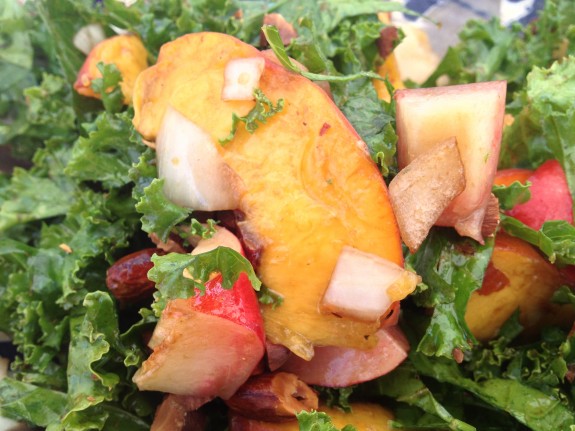
One reason I look forward to peach season is being able to make this recipe. This year, the peaches are abundant, sweet, juicy, and dense. Take advantage and find ways to include them in your recipes and meals, even if it’s just biting into a whole one and letting the juice roll down your arms. This salad is always a hit, perhaps because we’re naturally drawn to its variety of flavors, textures, colors, and shapes. Variety is the most significant reason we choose something to eat!
Salad With Summer Peaches, Fresh Kale, Toasted Almonds and a Balsamic Vinaigrette
Read More»Katherine’s Mantra for Transforming Your Life: Never Give In!
- At July 10, 2017
- By Katherine
- In Articles, News
 0
0
Thank you for writing me with your well wishes over the past few weeks. Your responses to my articles documenting my recent personal challenges have been heart-warming. I’ve especially enjoyed hearing your stories – many of you my clients – of how the skills I’m sharing in these pages are ones that have helped you maintain your healthy and happy lives. During my (25+ year) career, I’ve felt privileged to hear about your own life challenges through which you are working.
People look at my life and think it’s easy for me, and sometimes even tell me I couldn’t possibly relate to them or help them. I’m writing my story to disabuse you of that notion. Though, my clients very quickly perceive how similar my life has been to theirs, and understand why I’m so empathetic with their concerns.
“I’m no sacrosanct preacher looking down at a congregation of sinners. I’ve been there … And I know what it takes to come back from those depths of despair – and to stay on top!” I said in my book, Diet Simple. And I’d like to demonstrate how you can do the same, like my clients have, through the many years I’ve served them, and continue to do so.
I’ve been documenting my life’s recent transformation because I believe the steps I’m taking are relevant to anyone who wants to change their lives for the better. Everyone goes through hard times, and one of the most difficult, yet important skills for maintaining a healthy and happy lifestyle, is recovering from set backs.
One of my mantras through the years that I borrowed from Winston Churchill has been, “If you’re going through Hell, keep going … Never give in, never give in, never, never, never!” It is not always easy, including for me. That’s because we’re human and imperfect. But I firmly believe that we must live by this philosophy when it comes to doing good in the world or for ourselves.
In fact, studies of successful weight loss maintainers found that one of the differences between people who lose weight and keep it off versus those who relapse and gain their weight back is recovering from slips, instead of allowing them to snowball; seeing “mistakes” as normal, being kind to oneself, and getting over them.
My best case study demonstrating how powerful your response to slips can be is of Melissa, who spent many years struggling with her health and her weight. Today, Melissa is 50 pounds lighter than when we first started working together, maybe 15 years ago, and she’s kept it off for the past five years. But her journey was not an easy one. Melissa has insulin-dependent diabetes and was sent to me by her doctor to lose weight and improve her health. She desperately wanted to lose weight. She was 5’5″ tall, and slowly gained weight through her adult life until she weighed 200 pounds. She and her doctor wanted her to weigh under 150.
Like many people in Wahington, DC, Melissa is a highly educated, hard-working professional. She successfully directs a non-profit organization helping abused children. You could say Melissa – and her husband, John – are “workaholics.” They live for their work.
For at least ten years, Melissa would successfully change her habits and lose weight. Sometimes 20, sometimes 30 pounds. She’d feel happy, healthy, on top of the world; she loved the way she looked. But inevitably, when she’d go through difficult times – perhaps a holiday, a stressful family event, or a challenging work situation – she would slip up. And of course, you’re thinking, that’s normal, right? Well, Melissa didn’t feel that way. Any deviation from what she thought she should be doing made her feel so terrible that she’d fall into a depression. She was a perfectionist; and hard on herself. She started cancelling appointments, and wouldn’t return my calls. She disappeared. I lost contact with her. She gave up, felt ashamed. I felt terrible.
But amazingly she’d come back within a year or two – or three, though unfortunately having gained some, if not all, of her weight back. I was always happy to see her and pleased she was trying again. After about three failed attempts, we had (another) serious heart-to-heart about her perfectionism. We discussed her “disappearances,” which always led to weight re-gain. We discovered they were related to a slip she was ashamed of, or a time her work load or family life got too busy. She promised to never lose contact again. She agreed that no matter how hard things got that we would work through it together, no matter what.
Many times during our sessions (often by phone because she was so busy), Melissa would feel down and want to give up. But she promised to get in touch the next day(s) and to keep our appointment the following week, even if she felt she didn’t do well. This time we worked together, she kept her promises. Over time, she got used to “slipping up” now and then; she started regarding her slips as normal… okay… to be expected… and sometimes even planned as “splurges” or “taking a break.” Melissa had to learn how to get through the tough times, to put up with being too busy or stressed, feeling unsuccessful, or not getting results. And eventually, she’d always bounce back.
I enjoy staying in contact with Melissa. She sends me photos of herself at a gala, or in a new fabulous outfit, so I can see she’s having fun and staying fit. I like to keep up with how she and John are doing, and appreciate her staying in touch.
You could say I have a rewarding job. I would agree with you! Now, if I could only be perfect… Hmmmm
Working Through the Pain: Priming Your Mind for Change
- At July 03, 2017
- By Katherine
- In Articles, News
 0
0
I don’t know if you’ve noticed, but we humans don’t always think or behave rationally, even when it comes to our own self-interest. In fact, we can be so stubborn that we stand by while watching our own self-destruction. Sure, we want to make positive changes in our lives, and may even know what to do, but often can’t seem to overcome our inertia.
Changing your thinking, your emotions, and perhaps parts of your self-image may be necessary for becoming happier, healthier, more energetic, or achieving your ideal body weight. In the third installment describing my recent life transformation, I am sharing my progression through these steps (for the umpteenth time in my life), toward recovery from some difficult times.
Whether healing from an illness, surgeries, or even just experiencing a long run of being too busy to exercise or take care of yourself… Beginning again, becoming fit, or healthy can be a painful process and can seem almost impossible to achieve.
In my case, after knee and back surgeries, spending a good deal of time being sedentary, and even bed-bound, I tried jumping back into life too quickly many times. These false starts had the effect of delaying my healing, furthering my pain, exhaustion, and depression. I had to learn to take baby steps (funny, something I’m told I’m very good at helping my clients with while working toward improving their lives). I had to notice how my thinking, self-talk, emotions, and even my own identity were interfering with my successful recovery.
One of my revelations was that my self image as a fit and physically active person affected me negatively and slowed my progress for a couple of reasons. First, my inability to be physically active while recovering from surgeries made me perhaps more depressed than would be expected. That depression kept me from the world, isolated, and of course, we all know, that made my situation worse: physically and psychologically. Second, when I finally got the will to start moving, I didn’t know how to start slowly. I jumped right in, taking difficult yoga classes and walking too much. That caused pain and discouraged me from continuing to try. And this prolonged my convalescence.
After many such failures, I decided to try joining the world again. But this time, taking my own advice and doing it one baby step at a time! For this to work, I had to change my thinking. It is the cornerstone of any behavior change: Noticing your thoughts and deciding how to react to them. I decided it was time to notice the negative thoughts in my head that led to counterproductive behavior. Noticing self-defeating – and irrational – thoughts, such as “I’ll never be myself again,” or “I don’t want to go out and be seen unless I’m completely back in shape,” allowed me to change them to more rational and productive thoughts, such as, “of course, I’ll always be myself! And, besides, a little improvement is good for anyone,” or “people will still accept and like me, even if I’m not in great shape.” This officially is “cognitive therapy,” an accepted pre-requisite for behavior change, and one I use extensively to help my clients. My willingness to begin this process allowed me to accept my humanness, my need to proceed slowly. I decided to share my experience after finding so many people were surprised that this process could be difficult for me, the “expert.” I also wanted to share my experience so others would feel assured that this transformation is possible for anyone.
Before you can change the way you think, though, you’ll need to develop a sense of urgency about your goal, if you haven’t already. A sense of urgency, according to The Dalai Lama in “The Art of Happiness” – and scholars in this important field of psychological research, can be achieved two ways:
1) Remind yourself of your positive vision for success. For example, visualize yourself at your ideal fitness level, your goal weight, or see yourself feeling happy, healthy, energetic, and confident (see “Dream” in my book, Diet Simple), and
2) Ponder the negative consequences of not making a particular behavior change (a little fear can be a good thing – but just a little). I mean, after all, did I really want to feel terrible for the rest of my life? This may seem like an absurd question to ask yourself, but when your behavior doesn’t lead to positive outcomes, what else could the counter-productive behavior mean? What outcomes could you possibly expect besides negative ones? You may try this yourself by asking, for instance, in the morning as you’re considering two options: getting out of bed to exercise or sleeping just a little longer, “Do I want to feel good today? Or do I want to feel crummy today?” Another example, as you’re driving home from work and deciding to grab some carry-out or to go home to eat the healthy meal you’ve already planned. Ask yourself: “Do I want to achieve my weight loss goal (insert positive vision here) or will I accept being the same weight and having the same health problems for another year?” “Do I want to stop taking these darn medications or will I be taking them forever – and even increasing the dosage? What will my doctor say?” “What kind of example am I setting for my children, my spouse? Is this a behavior I can be proud of?” etc. You get the idea…
ACHIEVING INCREASED HAPPINESS
Outlining the consequenses of your actions and acting on your long term goals, as opposed to momentary desires, helps you grow as a person and become a happier person, according to scientific research. It increases your general happiness level because you are making decisions which contribute to your long-term goals.
THE DOWNWARD SPIRAL OF GIVING IN
Usually, when we do something that feels good momentarily, such as giving in and staying in bed for 30 more minutes of sleep in the morning instead of exercising, or grabbing a coffee cake at the coffee shop when we originally just planned on buying coffee, our happiness level may increase (“oooh, this feels yummy!”) – but it’s only a temporary blip of happiness. It goes back to the same level it did before – once the temporary experience wears off – and nothing changes for the better in our lives. We may even become more depressed as we continue to “give-in” to these unfulfilling momentary desires and dive into a downward spiral.
MAKING THE HARDER, BUT MORE SATISFYING CHOICE
If, instead, we say to ourselves, “I’m getting out of bed NOW! I’ll feel terrible if I don’t, and I’ll never achieve my goals,” or “Will stopping to get carry-out change my life for the better? I’d be better off going home and eating something healthy as I want to lose weight, lower my cholesterol, etc,” or “I really don’t need that coffee cake, and I’ll feel terrible after eating it, and will it make me happier at the end of the day?” “Will this increase my happiness for the short term? Or for the long term?” Another more extreme example might be a drug addict relapsing. It feels great momentarily, but the feeling doesn’t last.
When you make a more thoughtful decision, which contributes to your longterm health – physical or psychological – you are more likely to achieve your life’s hopes, dreams and goals, you can actually increase your happiness level, feel happier more often and grow as a person.
WHY IT’S NOT ALWAYS EASY
It is not always easy in our society to make the healthy decision. It’s easier – and the norm, in fact – to be unfit, overweight and unhealthy. But, I’m convinced it is possible to be healthy in an unhealthy world with planning, practice, determination, and support (I’m here any time you need me!) – Besides, what’s the alternative?
It takes effort to train your mind to work this way, but this is how we become better people and we advance as a society.



